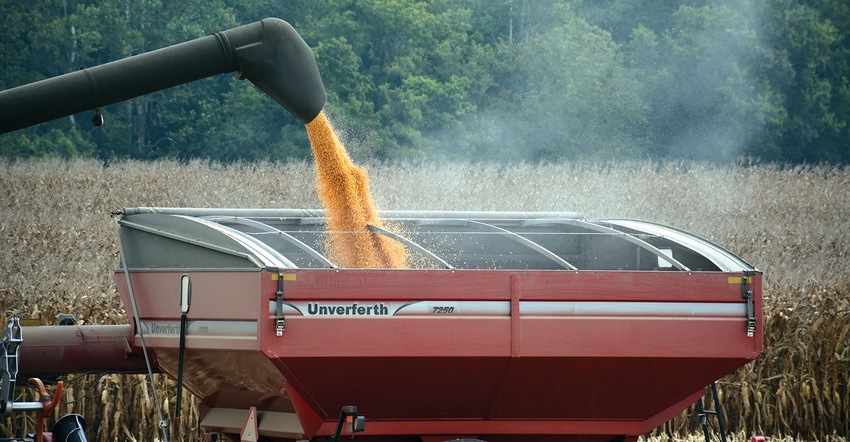
Before Mid-South farmers bring in their last loads of grain or haul the last bales of cotton to the gin, they should be considering what and how much to plant in 2020.
They also need to consider both production and market risk management options, says Louisiana State University Extension economist Michael Deliberto.
Deliberto, assistant professor, farm management and policy at the Louisiana State University Agricultural Center in Baton Rouge, says evaluating overall crop production plans is the first step.
"Enterprise budgets are farm planning tools that itemize production costs and evaluate income risks," he says. "Enterprise budgets tell you a lot. When evaluated over time, production costs and level of production allows producers to set an individualized farm benchmark for a particular field, crop and price outlook."
Budgets comparison tool
He says LSU AgCenter Extension has developed a corn, cotton and soybean comparison tool that allows producers to evaluate the net returns per acre of competing crops.
The tool allows growers to input their own cost, price, rental rate, and yield estimates. "The tool looks at different price points, costs and yields of two crops and evaluates how each crop performs (measured in net returns per acre)," Deliberto says. "We've had good success and feedback from the release of the tool. The tool lets producers make direct comparisons, subject to expected market performance of the crop."
Producers can find that tool at https://bit.ly/34Jizyl.
Deliberto says farmers should be considering input costs and deciding if buying in bulk ahead of need will save money. It's especially important, he says, with high management intensity cropland — irrigated cropland and crops with high fuel and fertilizer demands.
"Think about pre-buying diesel or nitrogen," he says.
"Also, ask yourself how sensitive your operations are to changes in prices or yields. Consider that exposure when evaluating the competitiveness of alternative enterprises. How does the expected return margin of corn compare to soybeans and how does the return margin of soybeans compare to that of cotton?"
Market quandary
Uncertain markets, Deliberto says, increase risk. It's not too early to evaluate marketing options and determine how to capitalize on short-lived price rallies.
He expects soybean markets to improve. "I think we will see an increase in soybean exports. China needs soybeans and Brazil is (out of the market)."
He adds that recent positive reports on the China-U.S. trade dispute could be a factor. "But will it translate into more shipments?
"China says it will purchase billions of dollars of ag products. Farmers are waiting to see if that comes to fruition."
Deliberto says increased exports should be positive for the soybean market as it will decrease carryout. "That would be a price-supporting move."
Based on current market factors, Deliberto expects Mid-South producers to plant more corn and soybeans in 2020.
In order to measure the magnitude of the corn and soybean plantings, he says producers should look at the soybean-to-corn ratio to evaluate corn and soybean opportunities. Projected prices are based on futures contracts. The soybean-to-corn price ratio is used to quantify relative returns between soybeans and corn. Higher price ratios indicate that soybeans are relatively more profitable than corn.
"Look at the ratio; when numbers go above 2.4 to 2.5, that favors soybeans. Numbers below 2.3 to 2.4 favor corn in the marketplace," he says. "The higher the soybean-corn ratio, the more attractive soybeans are to grow. The lower the ratio, the more attractive corn is to grow. The dividing point between soybeans and corn is a ratio value of around 2.35 or 2.4.
Uncertainty continues
"Going into winter and on to spring planting, look at contract offerings for the 2020 production year as a barometer to measure where market and acreage will go," he says.
Uncertainty is likely and depends, to some extent, on commitment of traders and spec money in the market.
He says to look at the fundamentals of supply and demand and local basis. "What does a decrease in abandonment for one crop year mean to new crop markets?"
Deliberto says fundamentals currently show cotton acreage decreasing in the Mid-South for 2020. "A lot of carry-in weighs on the market. Producers should look at the fundamentals, along with enterprise budgets, to judge how cotton competes with soybeans in the region."
He estimates that cotton acreage will be down; corn acreage will be up. "Producers should use information from their land-grant universities to evaluate crop mix, variety performance, and cost of production."
He says the comparison tool and enterprise budgets will help producers develop pricing thresholds and marketing and risk management for the overall farm management plan. "Know the breakeven cost," he says. "Understand the sensitivity of the operation to changes in price and yield expectations. How aggressive can you be with markets? Are you comfortable booking corn at $4.10 or do you want to risk waiting for $4.15?
Deliberto recommends producers take hard looks at input costs, including land rents and seed technology.
He said hybrid rice is a good example of the value of marginal analysis. Hybrids offer better yields, he says, but seed costs are expensive when compared to traditional rice varieties.
He recommends looking at crop insurance options. "Insurance premium is another line item expense to evaluate."
Capital investments
Look closely at capital purchases, Deliberto says. "Is it wise to invest in more on-farm grain storage this year? Is it smart to replace machinery? Can equipment go another year? Look at the prospect of repair costs and the risks of downtime."
He adds that if growers decide to cut production costs, they should cut wisely, evaluate savings against what they could lose with lower yield.
He says prices have rebounded a little, but to capitalize on any market movement, producers must know cost of production. That means hard looks at production history, and crop outlooks.
As harvest winds down, he says, farmers trade tractor and combine seats for desk chairs and computer screens. Fall is time to do homework.
About the Author(s)
You May Also Like






